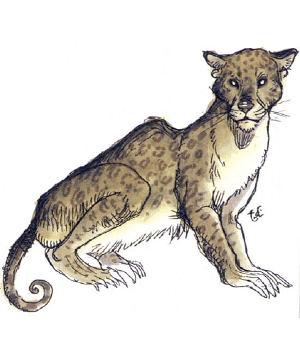

2145

| Climate/Terrain: | Tropical/subtropical jungle |
|---|---|
| Frequency: | Uncommon |
| Organization: | Solitary |
| Activity Cycle: | Night |
| Diet: | Carnivore |
| Intelligence: | Very (11-12) |
| Treasure: | D |
| Alignment: | Neutral evil |
| No. Appearing: | 1 |
| Armor Class: | 4 |
| Movement: | 15 |
| Hit Dice: | 5+2 |
| THAC0: | 15 |
| No. of Attacks: | 3 or 1 |
| Damage/Attack: | 1d3 (�2)/2d4 or by weapon |
| Special Attacks: | Rear-claw rake |
| Special Defenses: | Hit only by obsidian weapons, or by +1 or better weapons |
| Magic Resistance: | Nil |
| Size: | M (6-7’ long) |
| Morale: | Elite (13-14) |
| XP Value: | 975 |
Werejaguars are humans (or demihumans) who can transform into three distinct forms: that of a human, a large jaguar, and a hybrid form that combines the features of both human and jaguar. The creature’s human form is fairly unremarkable, although its hair might be sandy and streaked with black or vice versa, and its movements generally are fluid and graceful. The animal shape resembles a large jaguar perhaps 7 feet long from nose to rump. The hybrid aspect combines animal and human features: broad snout, blackmarked sandy pelt, wide paws that retain opposable thumbs, and a long, expressive tail.
Combat: In human form the werejaguar can wield normal weapons. In man-beast form it can use a weapon or attack using a claw/claw/bite routine. In animal form it cannot use a weapon. In either hybrid or animal form, if a werejaguar successfully bites a victim, it can then rake with its rear claws for an additional 1d4/1d4 damage. Rake attacks receive a +4 bonus because the victim is partially immobilized.
In their animal and hybrid forms, werejaguars can be harmed only by magical weapons or by those made of obsidian. Wounds from all other weapons heal so fast that they inflict no effective damage on the creature. Mercury — even in trace amounts — is immediately fatal when ingested.
If a werejaguar dies, it reverts to human form in one round.
Habitat/Society: If they live in the wilderness, werejaguars are usually solitary creatures. When the occasional family group is encountered, it will contain two adults and up to two offspring that are 1d6�10%, grown. At 50% of full growth, offspring fight as adults; otherwise, the adults protect their young with their lives, and they avoid encounters with adventurers and other hostiles.
Some werejaguars enjoy living in villages or small towns, but they are commonly uncomfortable in larger settlements (towns with a population of over 100, for example). Bearing this loose limitation in mind, they frequently prove very adept at infiltrating human society. In town, werejaguars can easily set aside their solitary tendencies and cooperate with others for as long as necessary. However, a werejaguar who has infiltrated human society will increasingly yearn to seek out an isolated area in which to relax and be alone.
Werejaguars do not marry, but they do have preferred mates. Females typically mate only with other we�jaguars. Males often impregnate human females and leave the area before the women realize the fell nature of the children they carry.
Ecology: Werejaguars are pure carnivores, and they subsist only on freshly killed meat. Although they greatly prefer the flavor of human and demihuman flesh, they can subsist on animal prey if necessary.

◆ 1197 ◆